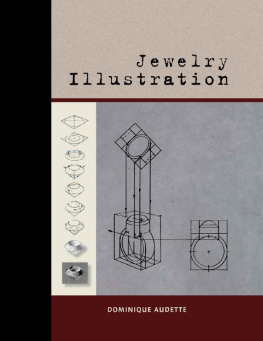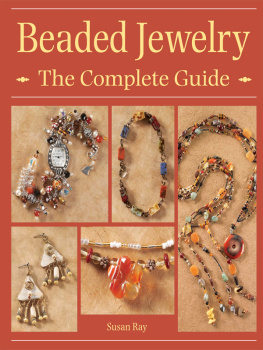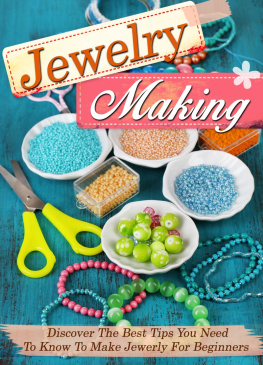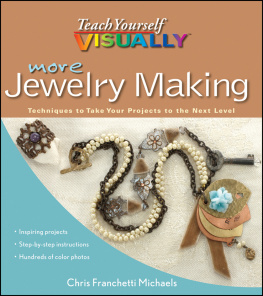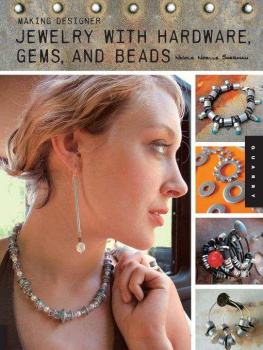Jewelry Illustration

Dominique Audette
Translated by Daniel Feldstein
English language edition
Brynmorgen Press, Brunswick, Maine USA
ISBN 1-978-929565-33-7
French language edition
Centre collgial de dveloppement de matriel didactique (CCDMD)
6220, rue Sherbrooke Est, bureau 416
Montral, Qubec H1N 1C1
ISBN 2-89470-183-7
Ebook production: booqlab.com
All rights reserved. No part of this publication may be reproduced or transmitted in any form or by any means, electronic or mechanical, including photocopying, recording, or any storage and retrieval system except by a reviewer who wishes to quote brief passages in connection with a review written for inclusion in a magazine, newspaper, web posting, or broadcast.
Acknowledgements
I would like to express our most sincere gratitude to the people who have helped me along the way, at one stage or another in the production of this book.
First, thank you to Micheline Boucher, Director at the cole de Joaillerie de Qubec, who, through her involvement and constant support, made the French and English editions possible.
For having backed the English edition of this work I thank Chantale Perreault, Director of the Centre collgial de dveloppement de matriel didactique at Collge de Maisonneuve in Montral.
For their discerning revision of the technical content, thanks go to Catherine Villeneuve and Serge Hbert, teachers.
For the digitizing of images, Normand Saint-Cyr, graphic artist.
For the translation, which remained faithful to the original text, Daniel Feldstein.
For the honor of his felicitous preface, Paul Bourassa, Curator at the Muse national des beaux-arts du Qubec, in Qubec City.
Thank you to my spouse, Mario Bland, for his unwavering support throughout the project.
Many thanks also to Avi Rachel Good for introducing us to Tim McCreight.
Lastly, a very special thank you to Tim McCreight and Abby Johnston for their professionalism, efficiency and for the lively discussions which always took place in a spirit of cordiality.
Dominique Audette

Contents
Foreword to the French Language Edition
The Line of Apelles and the O of Giotto
Many are the artistic legends recounted by the chroniclers of classical antiquity and the renaissance. Pliny the Elder, for example, told of the challenge issued by the Greek painter Apelles to his rival Protogenes. Apelles, visiting Protogeness studio and finding him away, picked up a brush and drew an extremely fine line across a panel. On his return, Protogenes realized that such perfection could only be the work of Apelles, and in answer, drew an even finer line over the first in another colour. Finally, Apelles, using another colour, split both of the previous lines by drawing a line so fine that it precluded any further attempts by Protogenes, who was forced to concede defeat. Writing more than one thousand years later, Giorgio Vasari recounted how the painter Giotto, responding to a request from the Popes messenger for a sample of his work, took a sheet of paper and a brush dipped in red, closed his arm to his side, so as to make a sort of compass of it, and then with a twist of his hand drew such a perfect circle that it was a marvel to see. The messenger asked if this was the only drawing he was to be given, to which Giotto declared: its more than enough. When the Pope was told of the circumstances under which the drawing was executed, he was struck with amazement.
Both of these stories attest to the precision of a drawing as a manifestation of talent. Ultimately, the line circumscribes the form, while at the same time, it is light and incorporeal, and therefore, borders on invisible. It is also captivating in its perfection. The line is also the architectonic principle in painting, as formulated by Leon Battista Alberti in his Della pittura (1436). Alberti, endeavouring to explain how objects are represented, postulated that circumscription registers the outline of the form in space, composition shows how its surfaces and planes are combined to create a structure, and the reception of light, defines the qualities given to the drawing through the addition of lights and shadows.
In this masterly treatise on jewelry illustration, Dominique Audette follows this same path. And to call it a treatise is no exaggeration, since it systematically covers all aspects of the discipline, from the basic concepts of technical drawing, to their application to various types of jewelry through selected examples, to a series of exercises designed to reinforce the subject matter. While not a substitute for your own inspiration or creative spark, this book is a remarkable and powerful tool that will help you express your ideas on paper. To borrow from Boileau, we might say: what is clearly conceived can be clearly drawn, and the lines with which to describe it come with ease.
As a teacher of jewelry making, and particulry jewelry illustration for over twenty years, Dominique Audette was quick to realize that a manual of this type was long overdue. It re-elevates technique to its noble status as a revealer of knowledge, reminding us of the true meaning of the Greek techne. And while some of its plates reflect the art of the geometer, others are clearly the province of the painter. Bridging the gap between them, Dominique Audette retraces the path forged by the humanists of the Renaissance.
Paul Bourassa
Curator of Exhibitions and Director of Development Architecture, Decorative Arts, Design and Fine Crafts
Muse national des beaux-arts du Qubec
Foreword to the English Language Edition
In the Renaissance, it was typical for an artists training to include goldsmithing. Cellini, Donatello, Brunelleschi, and Ghiberti all used the compact realm of jewelry and ceremonial objects to develop their understanding of structure, harmony, and ornament. We know this because of the drawings they left behindluscious complicated designs of vines and goddesses, far removed from our modern tastes but wonderful to see all the same.
Even with the advent of computer rendering technology and 500 years of industrial development, the wisdom of the Renaissance remains. There is something special, something important and potent that happens when a human hand moves a pencil across a paper. This book celebrates the timeless magic of illustration as it generously yields its techniques.
There are people who have a natural ability to draw so things look real. They will find in these pages the geometric logic that lifts their intuitive skills to new levels of precision. And there are those whose boxes fall flat and whose spheres refuse to fill a genuine space. They will be thrilled with the systematic instruction found here. It can be said with confidence that nothing in this book is beyond the reach of a dedicated student. The instructions are that good.
Turn the pages and you will see lovely drawings. Rings take shape and lift off the pages; gems sparkle, and necklaces lay gracefully around a neck. As wonderful as these drawings are, the importance of this book lies in the power it offers to breathe life into designs of your own imagination. Magic indeed!
Tim McCreight
Teacher, designer, jeweler

Introduction
The drawing method I teach consists of a collection of recognized techniques adapted to the illustration of jewelry. Whether applied to technical drawing with instruments, orthographic projection, two-point perspective, freehand drawing, the use of light and shadow or rendering gemstones, it can be reduced to a logically presented series of three-dimensional geometric figures.

